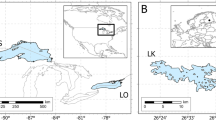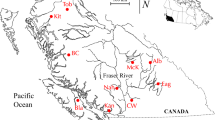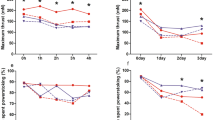Abstract
The vulnerability of fish populations to climate change is driven primarily by impacts on their most vulnerable life stages. The earliest life stages may, in many cases, be more thermally sensitive than juvenile and adult fish, as developing embryos cannot behaviourally thermoregulate. We quantified the survivorship of brook trout (Salvelinus fontinalis) embryos under a range of winter thermal regimes. In the laboratory, embryos from four populations with varying amounts of native or hatchery-introgressed ancestry were reared under four simulated winter thermal regimes relevant to the central portion of the species’ range: ambient stream temperatures, ambient + 2 °C, ambient with a simulated winter snowmelt event, and ambient followed by an early rise to spring temperatures. Embryo survival (hatching success) differed significantly among populations across all thermal regimes, with the pure native population having the lowest survival. No consistent differences in survivorship across thermal regimes were detected, although native populations exhibited more among-family variability in response to thermal stress. Our study does not align closely with others that found reduced embryo survival under thermal stress, but concurs with observations of substantial intraspecific variation in thermal performance in coldwater fishes. Our results suggest that brook trout embryos may be somewhat resilient in the face of warmer and more variable incubation conditions, but it is likely that their resiliency varies among populations. Future experiments that include more extreme and variable conditions to clarify environmental limits of early life stages of brook trout would be useful for conservation planning.






Similar content being viewed by others
Data availability
Data generated or analyzed during this study are available in the FigShare repository. [Data: https://doi.org/10.6084/m9.figshare.24602223.v1; R Script: https://doi.org/10.6084/m9.figshare.24602235].
References
Alshamlih MM (2014) Comparative evaluation of effective population size genetic estimation methods in wild brook trout (Salvelinus fontinalis) populations. Dissertation, Trent University. https://digitalcollections.trentu.ca/objects/etd-168
Argent DG, Kimmel WG (2013) Potential impacts of climate change on brook trout (Salvelinus fontinalis) populations in streams draining the Laurel Hill in Pennsylvania. J Freshw Ecol 28:489–502. https://doi.org/10.1080/02705060.2013.784880
Baird HB, Krueger CC, Josephson DC (2002) Differences in incubation period and survival of embryos among brook trout strains. N Am J Aquac 64:233–241. https://doi.org/10.1577/1548-8454(2002)064%3C0233:DIIPAS%3E2.0.CO;2
Balon EK (1980) Early ontogeny of the brook charr, Salvelinus (Baione) fontinalis. In: Balon EK (ed) Charrs: salmonid fishes of the genus salvelinus. Dr.W. Junk Publishers, The Hague, pp 632–666
Bassar RD, Letcher BH, Nislow KH, Whiteley AR (2016) Changes in seasonal climate outpace compensatory density-dependence in eastern brook trout. Glob Change Biol 22:577–593. https://doi.org/10.1111/gcb.13135
Beacham TD, Murray CB (1986) Effects of transferring pink (Oncorhynchus gorbuscha) and chum (Oncorhynchus keta) salmon embryos at different developmental stages to a low incubation temperature. Can J Zool 65:96–105. https://doi.org/10.1139/z87-015
Briggs MA, Lane JW, Snyder CD, White EA, Johnson ZC, Nelms DL, Hitt NP (2018) Shallow bedrock limits groundwater seepage-based headwater climate refugia. Limnologica 68:142–156. https://doi.org/10.1016/j.limno.2017.02.005
Chadwick JG Jr, Nislow KH, McCormick SD (2015) Thermal onset of cellular and endocrine stress responses correspond to ecological limits in brook trout, an iconic cold-water fish. Conserv Physiol 3:cov017. https://doi.org/10.1093/conphys/cov017
Chu C, Mandrak NE, Minns CK (2005) Potential impacts of climate change on the distributions of several common and rare freshwater fishes in Canada. Divers Distrib 11:299–310. https://doi.org/10.1111/j.1366-9516.2005.00153.x
Chu C, Jones NE, Mandrak NE, Piggott AR, Minns CK (2008) The influence of air temperature, groundwater discharge, and climate change on the thermal diversity of stream fishes in southern Ontario watersheds. Can J Fish Aquat Sci 65:297–308. https://doi.org/10.1139/f08-007
Clusella-Trullas S, Blackburn TM, Chown SL (2011) Climate predictors of temperature performance curve parameters in ectotherms imply complex responses to climate change. Am Nat 177:738–751. https://doi.org/10.1086/660021
Cook CJ, Burness G, Wilson CC (2018) Metabolic rates of embryos and alevin from a cold-adapted salmonid differ with temperature, population and family of origin: implications for coping with climate change. Conserv Physiol 6:cox076. https://doi.org/10.1093/conphys/cox076
Cook CJ, Wilson CC, Burness G (2018) Impacts of environmental matching on the routine metabolic rate and mass of native and mixed-ancestry brook trout (Salvelinus fontinalis) fry. Conserv Physiol 6:coy023. https://doi.org/10.1093/conphys/coy023
Cribari-Neto F, Zeileis A (2010) Beta Regression in R. J Stat Soft 34:1–24. https://doi.org/10.18637/jss.v034.i02
Curry RA, Noakes DLG (1995) Groundwater and the selection of spawning sites by brook trout (Salvelinus fontinalis). Can J Fish Aquat Sci 52:1733–1740. https://doi.org/10.1139/f95-765
Curry RA, Noakes DLG, Morgan GE (1995) Groundwater and the incubation and emergence of brook trout (Salvelinus fontinalis). Can J Fish Aquat Sci 52:1741–1749. https://doi.org/10.1139/f95-766
Dahlke FT, Wohlrab S, Butzin M, Pörtner H (2020) Thermal bottlenecks in the life cycle define climate vulnerability of fish. Science 369:65–70. https://doi.org/10.1126/science.aaz3658
Dahlke FT, Wohlrab S, Butzin M, Pörtner H (2022) Reply to: methodological inconsistences define thermal bottlenecks in fish life cycle. Evol Ecol 36:293–298. https://doi.org/10.1007/s10682-022-10154-z
Darwish TL, Hutchings JA (2009) Genetic variability in reaction norms between farmed and wild backcrosses of Atlantic Salmon (Salmo salar). Can J Fish Aquat Sci 66:83–90. https://doi.org/10.1139/F08-185
Del Rio AM, Mukai GN, Martin BT, Johnson RC, Fangue NA, Isreal JA, Todgham AE (2021) Differential sensitivity to warming and hypoxia during development and long-term effects of developmental exposure in early life stage Chinook salmon. Conserv Physiol 9:coab054. https://doi.org/10.1093/conphys/coab054
Eliason EJ, Clark TD, Hague MJ, Hanson LM, Gallagher ZS, Jeffries KM, Gale MK, Patterson DA, Hinch SG, Farrell AP (2011) Differences in thermal tolerance among sockeye salmon populations. Science 332:109–112. https://doi.org/10.1126/science.1199158
Fraser DJ, Weir LK, Bernatchez L, Hansen MM, Taylor EB (2011) Extent and scale of local adaptation in salmonid fishes: a review and meta-analysis. Heredity 106:404–420. https://doi.org/10.1038/hdy.2010.167
Fry FEJ, Hart JS, Walker KF (1946) Lethal temperature relations for a sample of young speckled trout, Salvelinus fontinalis. Univ Tor Stud Biol Ser 54:9–35
Gradil KJ, Garner SR, Wilson CC, Farrell AP, Neff BD (2016) Relationship between cardiac performance and environment across populations of Atlantic salmon (Salmo salar): a common garden experiment implicates local adaptation. Evol Ecol 30:877–886. https://doi.org/10.1007/s10682-016-9847-2
Gunn J, Snucins E (2010) Brook charr mortalities during extreme temperature events in Sutton River, Hudson Bay Lowlands, Canada. Hydrobiologia 650:79–84. https://doi.org/10.1007/s10750-010-0201-3
Hamdoun A, Epel D (2007) Embryo stability and vulnerability in an always changing world. Proc Natl Acad Sci U S A 104:1745–1750. https://doi.org/10.1073/pnas.0610108104
Haxton T, Ball H, Armstrong K (2020) Expert opinion on the status and stressors of brook trout, Salvelinus fontinalis, in Ontario. Fish Manag Ecol 27:111–122. https://doi.org/10.1111/fme.12376
Hokanson KEF, McCormick JH, Jones BR, Tucker JH (1973) Thermal requirements for maturation, spawning, and embryo survival of the brook trout, Salvelinus fontinalis. J Fish Res Board Can 30:975–984. https://doi.org/10.1139/f73-158
Isaak DJ, Luce CH, Horan DL, Chandler GL, Wollrab SP, Nagel DE (2018) Global warming of salmon and trout rivers in the northwestern U.S.: Road to ruin or path through purgatory? Trans Am Fish Soc 147:566–587. https://doi.org/10.1002/tafs.10059
Jeuthe H, Brännäs E, Nilsson J (2016) Effects of variable egg incubation temperatures on the embryonic development in Arctic charr Salvelinus alpinus. Aquac Res 47:3753–3764. https://doi.org/10.1111/are.12825
Kanno Y, Pregler KC, Hitt NP, Letcher BH, Hocking DJ, Wofford JEB (2016) Seasonal temperature and precipitation regulate brook trout young-of-the-year abundance and population dynamics. Freshw Biol 61:88–89. https://doi.org/10.1111/fwb.12682
Laurel BJ, Hunsicker ME, Ciannelli L, Hurst TP, Duffy-Anderson J, O’Malley R, Behrenfeld M (2021) Regional warming exacerbates match/mismatch vulnerability for cod larvae in Alaska. Prog Oceanogr 193:102555. https://doi.org/10.1016/j.pocean.2021.102555
Lavery JM, Cunjak RA (2019) The influence of abiotic incubation conditions on the winter mortality of wild salmonid embryos. Freshw Biol 64:1098–1113. https://doi.org/10.1111/fwb.13280
Lenth R (2022) emmeans: Estimated Marginal Means, aka Least-Squares Means. R package version 1.7.3. https://CRAN.R-project.org/package=emmeans
Lüdecke D, Ben-Shachar MS, Patil I, Waggoner P, Makowksi D (2021) performance: An R Package for Assessment, Comparison and Testing of Statistical Models. J Open Source Softw 6:3139. https://doi.org/10.21105/joss.03139
MacCrimmon HR, Campbell JS (1969) World distribution of brook trout, Salvelinus fontinalis. J Fish Res Board Can 26:1699–1725. https://doi.org/10.1139/f69-159
MacKay HH (1963) Fishes of Ontario (The Ontario Department of Lands and Forests). The Bryant Press Ltd., Toronto, Ontario, Canada
Mackey TE, Hasler CT, Durhack T, Jeffrey JD, Macnaughton CJ, Ta K, Enders EC, Jeffries KM (2021) Molecular and physiological responses predict acclimation limits in juvenile brook trout (Salvelinus fontinalis). J Exp Biol 224:jeb241885. https://doi.org/10.1242/jeb.241885
Marten PS (1992) Effect of temperature variation in the incubation and development of brook trout eggs. Prog Fish-Cult 54:1–6. https://doi.org/10.1577/1548-8640(1992)054%3c0001:EOTVOT%3e2.3.CO;2
Mazerolle MJ (2020) AICcmodavg: Model selection and multimodel inference based on (Q)AIC(c). R package version 2.3–1 https://cran.r-project.org/package=AICcmodavg
McCormick JK, Hokanson KEF, Jones BR (1972) Effects of temperature on growth and survival of young brook trout, Salvelinus fontinalis. J Fish Res Board Can 29:1107–1112. https://doi.org/10.1139/f72-165
McDermid JL, Fischer FA, Alshamlih M, Sloan WN, Jones NE, Wilson CC (2012) Variation in acute thermal tolerance within and among hatchery strains of brook trout. Trans Amer Fish Soc 141:1230–1235. https://doi.org/10.1080/00028487.2012.688917
McKenzie DJ, Zhang Y, Eliason EJ, Schulte PM, Claireaux G, Blasco FR, Nati JJH, Farrell AP (2021) Intraspecific variation in tolerance of warming in fishes. J Fish Biol 98:1536–1555. https://doi.org/10.1111/jfb.14620
Morash AJ, Neufeld C, MacCormack TJ, Currie S (2018) The importance of incorporating natural thermal variation when evaluating physiological performance in wild species. J Exp Biol 221:jeb164673. https://doi.org/10.1242/jeb.164673
Mueller CA, Eme J, Manzon RG, Somers CM, Boreham DR, Wilson JY (2015) Embryonic critical windows: changes in incubation temperature alter survival, hatchling phenotype, and cost of development in lake whitefish (Coregonus clupeaformis). J Comp Physiol B 185:315–331. https://doi.org/10.1007/s00360-015-0886-8
Murray CB, Beacham TD (1986) Effect of varying temperature regimes on the development of pink salmon (Oncorhynchus gorbuscha) eggs and alevins. Can J Zool 64:670–676. https://doi.org/10.1139/z86-099
Murray CB, Beacham TD (1987) The development of Chinook (Oncorhynchus yschawytscha) and chum salmon (Oncorhynchus keta) embryos and alevins under varying temperature regimes. Can J Zool 65:2672–2681. https://doi.org/10.1139/z87-406
Narum SR, Campbell NR, Kozfkay CC, Meyer KA (2010) Adaptation of redband trout in desert and montane environments. Mol Ecol 19:4622–4637. https://doi.org/10.1111/j.1365-294X.2010.04839.x
Ontario Ministry of Natural Resources and Forestry (2005) Stocks Catalogue. Fish Culture Section, Ontario Ministry of Natural Resources and Forestry. Peterborough, ON.
Pörtner HO, Peck MA (2010) Climate change effects on fishes and fisheries: towards a cause-and-effect understanding. J Fish Biol 77:1745–1779. https://doi.org/10.1111/j.1095-8649.2010.02783.x
Pörtner HO, Bennett AF, Bozinovic F, Clarke A, Lardies MA, Lucassen M, Pelster B, Schiemer F, Stillman JH (2006) Trade-offs in thermal adaptation: the need for a molecular to ecological integration. Physiol Biochem Zool 79:295–313. https://doi.org/10.1086/499986
Pottier P, Burke S, Drobniak SM, Nakagawa S (2022) Methodological inconsistencies define thermal bottlenecks in fish life cycle: a comment on Dahlke et al. 2020. Evol Ecol 36:287–292. https://doi.org/10.1007/s10682-022-10157-w
Power G (1980) The brook charr, Salvelinus fontinalis. In: Balon EK (ed) Charrs: Salmonid Fishes of the Genus Salvelinus. Dr.W. Junk Publishers, The Hague, pp 141–203
R Core Team (2022) R: A language and environment for statistical computing. R Foundation for Statistical Computing, Vienna, Austria (https://www.R-project.org/)
Rahel FJ, Keleher CJ, Anderson JL (1996) Potential habitat loss and population fragmentation for cold water fish in the North Platte River drainage of the Rocky Mountains: response to climate warming. Limnol Oceanogr 41:1116–1123. https://doi.org/10.4319/lo.1996.41.5.1116
Régnier T, Gibb FM, Wright PJ (2019) Understanding temperature effects on recruitment in the context of trophic mismatch. Sci Rep 9:15179. https://doi.org/10.1038/s41598-019-51296-5
Reid D, Armstrong JD, Metcalfe NB (2012) The performance advantage of a high resting metabolic rate in juvenile salmon is habitat dependent. J Anim Ecol 81:868–875. https://doi.org/10.1111/j.1365-2656.2012.01969.x
Reid CH, Patrick PH, Rytwinski T, Taylor JJ, Willmore WG, Reesor B, Cooke SJ (2022) An updated review of cold shock and cold stress in fish. J Fish Biol 100:1102–1137. https://doi.org/10.1111/jfb.15037
Ridgway MS (2008) A roadmap for coasters: landscapes, life histories, and the conservation of brook trout. Trans Am Fish Soc 137:1179–1191. https://doi.org/10.1577/T05-268.1
Román-Palacios C, Wiens JJ (2020) Recent responses to climate change reveal the drivers of species extinction and survival. Proc Natl Acad Sci U S A 117:4211–4217. https://doi.org/10.1073/pnas.1913007117
Saunders RL, Muise BC, Henderson EB (1975) Mortality of salmonids cultured at low temperature in sea water. Aquac 5:243–252. https://doi.org/10.1016/0044-8486(75)90002-2
Smith DA, Ridgway MS (2019) Temperature selection in brook charr: lab experiments, field studies, and matching the fry curve. Hydrobiologia 840:143–156. https://doi.org/10.1007/s10750-018-3869-4
Stitt BC, Burness G, Burgomaster KA, Currie S, McDermid JL, Wilson CC (2014) Intraspecific variation in thermal tolerance and acclimation capacity in brook trout (Salvelinus fontinalis): physiological implications for climate change. Physiol Biochem Zool 87:15–29. https://doi.org/10.1086/675259
Todgham AE, Iwama GK, Schulte PM (2006) Effects of the natural tidal cycle and artificial temperature cycling on Hsp levels in the tidepool sculpin Oligocottus masculosus. Physiol Biochem Zool 79:1033–1045. https://doi.org/10.1086/507664
Vasseur DA, DeLong JP, Gilbert B, Greig HS, Harley CDG, McCann KS, Savage V, Tunney TD, O’Connor MI (2014) Increased temperature variation poses a greater risk to species than climate warming. Proc Royal Soc B 281:rspb.2013.2612. https://doi.org/10.1098/rspb.2013.2612
Wells ZRR, McDonnell LH, Chapman LJ, Fraser DJ (2016) Limited variability in upper thermal tolerance among pure and hybrid populations of a cold-water fish. Conserv Physiol 4:cow063. https://doi.org/10.1093/conphys/cow063
Whitney CK, Hinch SG, Patterson DA (2013) Provenance matters: thermal reaction norms for embryo survival among sockeye salmon Oncorhynchus nerka populations. J Fish Biol 82:1159–1176. https://doi.org/10.1111/jfb.12055
Wilder AS, Wilson CC, Warriner TR, Semeniuk CAD (2022) Effects of generations in captivity and elevated rearing temperature on Ontario hatchery brook trout (Salvelinus fontinalis) fry quality and survival. BioRxiv. https://doi.org/10.1101/2022.10.01.510397
Acknowledgements
The authors would like to thank Scott Ferguson, Bradley Howell, Dustin Boczek, Mikkaella Hurley, and Derek Lipskie for their assistance with animal care, as well as Christian Bihun and Jacob Bowman for their assistance with mapping software.
Funding
This work was supported by the Ontario Ministry of Natural Resources and Forestry, Trent University, and a Natural Sciences and Engineering Research Council of Canada (NSERC) Discovery Grant (to G.D.R).
Author information
Authors and Affiliations
Contributions
Conceptualization: Erin Stewart, Chris Wilson, Graham Raby; Funding acquisition: Chris Wilson, Graham Raby; Data curation: Erin Stewart; Formal Analysis: Erin Stewart; Investigation: Erin Stewart, Emily Lechner, Vince Frasca; Methodology: Erin Stewart, Vince Frasca, Chris Wilson, Graham Raby; Project administration: Erin Stewart, Chris Wilson, Graham Raby; Visualization: Erin Stewart; Resources: Vince Frasca, Chris Wilson; Supervision: Chris Wilson, Graham Raby; Writing – original draft: Erin Stewart; Writing – review & editing: Erin Stewart, Emily Lechner, Vince Frasca, Chris Wilson, Graham Raby.
Corresponding author
Ethics declarations
Competing interest
The authors declare there are no competing interests.
Additional information
Publisher's Note
Springer Nature remains neutral with regard to jurisdictional claims in published maps and institutional affiliations.
Supplementary information
Below is the link to the electronic supplementary material.
Rights and permissions
Springer Nature or its licensor (e.g. a society or other partner) holds exclusive rights to this article under a publishing agreement with the author(s) or other rightsholder(s); author self-archiving of the accepted manuscript version of this article is solely governed by the terms of such publishing agreement and applicable law.
About this article
Cite this article
Stewart, E.M.C., Lechner, E.R., Frasca, V.R. et al. Differences in embryo survivorship among populations of brook trout (Salvelinus fontinalis) under variable winter thermal regimes. Environ Biol Fish 107, 189–202 (2024). https://doi.org/10.1007/s10641-024-01524-3
Received:
Accepted:
Published:
Issue Date:
DOI: https://doi.org/10.1007/s10641-024-01524-3




